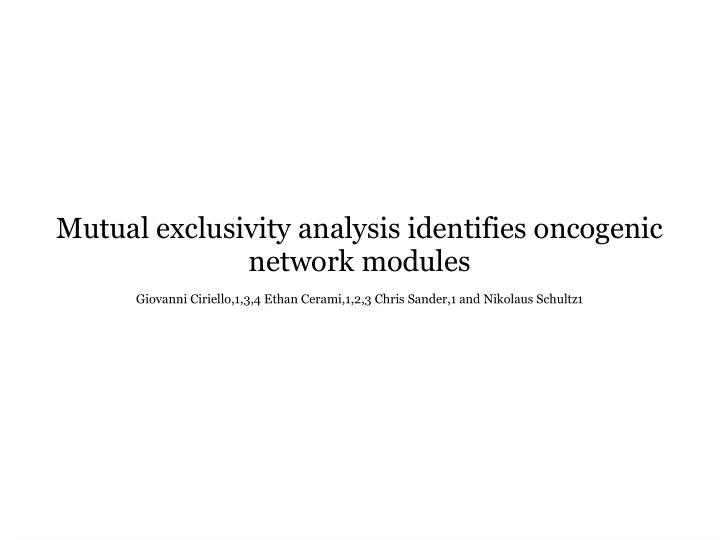

Mutual exclusivity analysis identifies oncogenic network modules Giovanni Ciriello,1,3,4 Ethan Cerami,1,2,3 Chris Sander,1 and Nikolaus Schultz1
Background Motivation Method Result
Background Pathway Smallest functional unit of a network of proteins that interacts to performs a single task.
Background Network Union of all pathways
Motivation Basic motivation: to identify oncogenic pathway modules.
Why Mutual exclusivity analysis? Many oncogenic events effect a limited number of biological pathways Mutually exclusive genomic alteration observed
Example P53 VS MDM2
Goal of MEMo Identify sets of connected genes that are recurrently altered, likely belongs to the same pathway or biological process, and exhibit patterns of mutually exclusive generic alteration across multiple patients.
Method
Step 1: Build Binary Event Matrix of Significant Altered Genes ● The first filter identifies genes that are mutated significantly above the background mutation rate (BMR). ● The second filter identifies genes that are targets of recurrent copy number amplification or deletion. ● The third filter identifies copy number altered genes that have concordant mRNA expression
Note ● Genes that does not have a concordant mRNA expression would not likely to change the pathway function and therefore unlikely to be drivers. ● The binary matrix built does not take into account for the multiply mutation within a gene/case, nor does it not account for varying allelic frequency
Step 2: Identifying all gene pairs likely to be involved in the same pathway
Step 3: Build graph of gene pairs and extract clique
Similarity metric between genes J ( u ,v )= ∣ N ( u )∪ N ( v ) ∣ N ( u )∩ N ( v ) J avg is 4% to 7% for known gene pairs that have similar functions
Connecting similar genes If a pair of genes has a high J value, marked them as functional similar and connect them.
Clique extraction
Non informative clique deletion A clique is said to be informative if number of times the corresponding gene is altered concurrently with other genes in the clique is smaller than the number of unique alterations
Step 4: Mutual exclusivity test
Result
Recommend
More recommend